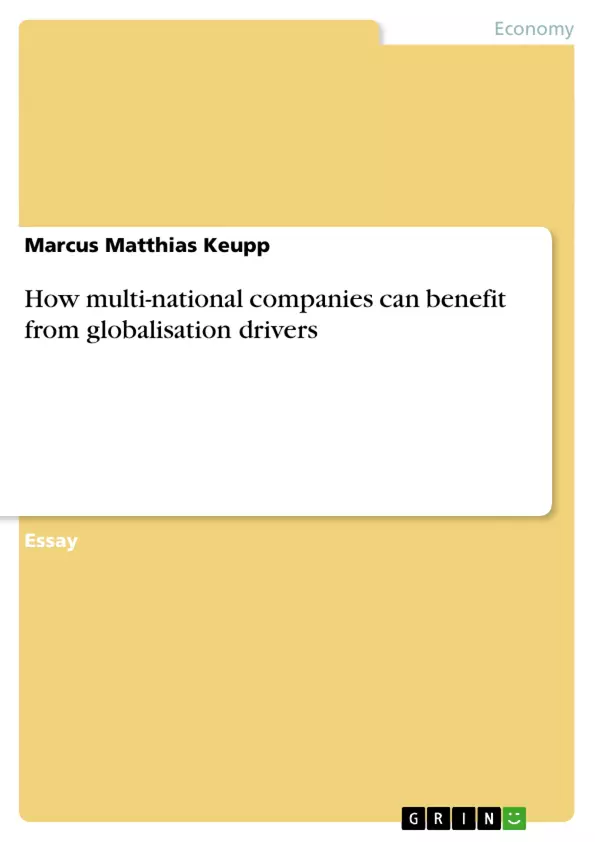This essay describes global drivers leading to the increased emergence of strategic alliances (SAs) and cross-border joint-ventures (JVs) and implied potential benefits for multinational firms (MNEs).
Applying Yip′s framework1 (viz. appendix), drivers and benefits are analysed. It will be shown that importance of drivers and likelihood benefits hinge upon the MNE and its industry and determine its engagement in SAs and JVs.
Inhaltsverzeichnis (Table of Contents)
- Introduction
- Definitions
- Global Drivers
- Changing World Markets
- Macroeconomic Change
- Technology
- Customers
- Production and Distribution
- Benefits
- New Markets
- Strategic Advantage
- Skills/Knowledge
- Products
- Governmental risks
- Conclusion
Zielsetzung und Themenschwerpunkte (Objectives and Key Themes)
This essay explores the drivers of globalization that lead to increased strategic alliances (SAs) and cross-border joint ventures (JVs) by multinational firms (MNEs). It applies Yip's framework¹ to analyze the drivers and benefits of such collaborations for MNEs. The essay aims to demonstrate that the importance of these drivers and the likelihood of benefits hinge upon the specific MNE, its industry, and its overall engagement in SAs and JVs.
- Drivers of globalization impacting MNEs
- Benefits for MNEs from engaging in SAs and JVs
- Importance of drivers and benefits depending on the MNE and its industry
- Analysis of Yip's framework for understanding global strategy
- Examples of successful and unsuccessful strategic alliances and joint ventures
Zusammenfassung der Kapitel (Chapter Summaries)
- Introduction: This chapter outlines the essay's scope and objectives, focusing on the relationship between globalization drivers, strategic alliances, and joint ventures for multinational companies. It introduces Yip's framework, which will be used to analyze the drivers and benefits of such collaborations.
- Definitions: This chapter clarifies key terms, defining multinational firms (MNEs), strategic alliances (SAs), and international (cross-border) joint ventures (JVs). It highlights the importance of understanding these definitions for accurately analyzing the dynamics of global business collaborations.
- Global Drivers: This chapter examines the external factors driving globalization and shaping the strategic decisions of MNEs. It discusses key drivers such as changing world markets, macroeconomic change, technology advancements, customer demands, and production and distribution considerations. Each driver's importance is evaluated based on its influence on specific industries and firms.
- Benefits: This chapter explores the potential advantages for MNEs derived from engaging in SAs and JVs. It focuses on benefits such as accessing new markets, achieving strategic advantage, gaining access to skills and knowledge, expanding product portfolios, and navigating governmental risks. The relative importance of these benefits is assessed in relation to the specific needs and goals of individual MNEs and industries.
Schlüsselwörter (Keywords)
This essay focuses on globalization drivers, strategic alliances, joint ventures, multinational firms, Yip's framework, benefits, new markets, strategic advantage, skills and knowledge, product portfolio expansion, and governmental risks.
- Quote paper
- Marcus Matthias Keupp (Author), 2001, How multi-national companies can benefit from globalisation drivers, Munich, GRIN Verlag, https://www.grin.com/document/7764



